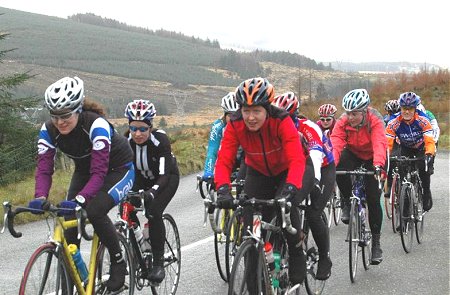 |
| Olympian Jenny Mc Auley leading a Training session |
Control the training load for maximum improvements.
If you want to get the most benefits for the amount of hours, kilometres and effort that you put into your club training, control the training loads so that everyone in the group receives benefits from the session.
Each of us are unique human beings and physical capacity differs greatly between individuals. The best quote I heard in regard to training about the these differences in ability was from a runner, when he said to me 'one athletes warm up is another athletes speed session' that gives you a great picture in your mind of some runners cruising along and the others struggling in their wake.
So if we begin from that point it seems to be saying, choose your training partners very well. How many riders train in groups that are too fast for them, try to do the same amount of work as the strong riders in the group and then wonder when they are wrecked and not improving? This approach can very quickly lead to overtraining and loss of enthusiasm for riders who may not be fit or strong as other riders in his/her training group.
The good news is that this effect of the physical differences is not so pronounced with cycling compared to runners as some of the differences in cyclist's ability / power output can be overcome by the drafting effect. Riders of different abilities can train effectively in the same group and get a good workout. Obviously there are limits to the size of the difference and training effectiveness.
So for example while doing the long steady miles (they are steady aren't they?) a rider who is not so fit or strong in comparison to other riders in the training group can improve their fitness by mainly sitting in the training group and gradually doing a bit more at the front over the weeks as their fitness improves. The goal for these sessions should be for everyone to have a workout according to their ability and fitness and come home in reasonable shape. The strong riders who want to do a lot of work can stay on the front longer when doing their turns.
For this to work well there must be trust and agreement. It can be achieved very well by having an agreement that the group is there for everyone's benefit. And trust between the riders in the group that riders will spend more or less time on the front according to their fitness and training goals. Also agreement that as rider's fitness improves they will gradually do some more turns or longer turns at the front and that the goal for the session is training and not a race.
This might not be the norm everywhere. In some groups it might be a case that one or two individuals call the shots and the training is geared towards their needs and gaol's
only.
BENEFITS OF THE AGREED APPROACH
- Sessions will be more enjoyable
- More riders will improve their fitness
- New riders will gain more experience
- It will develop more group cohesion
- More riders will get to the start of the season and finish the season
- Fewer riders will over-train
For example juniors or riders new to cycling can gain so much practical knowledge from training in groups with seniors and vets, but they may not always be strong enough to take their turns when due at the front of the group. However they might be allowed to just go up and down the line according to their fitness and not for every turn. Obviously as their fitness improves they can do some more turns at the front.
This works very well for the long easy / steady sessions when the differences are not too big between riders For more intensive or hilly sessions sessions where riders are under more pressure the group needs to be made up of riders of around the same ability.
To give some examples of the drafting effect, studies with world class Team Pursuit teams (male) show that the leading riders power output is around 600-650 watts compared to the rider is in the third or fourth position when the power output is reduced to 350-400 watts (A Jeukendrup Performance cycling)
I also enclose some examples of some riders tests below with recommendations for power and Heart rate ranges for their long aerobic cycling sessions. You can clearly see how they could train well together in the same group.
Rider A |
Power watts |
Heart rate |
120
150
180 |
130
145
153 |
Rider B |
Power Watts |
Heart rate |
120
150
180
210 |
128
137
147
157 |
Rider C |
Power watts |
Heart rate |
120
150
180 |
122
140
157 |
So have the meeting organise the group and have agreed goals, you'll see the benefits in the races when the sun is shining!
Enjoy your cycling.